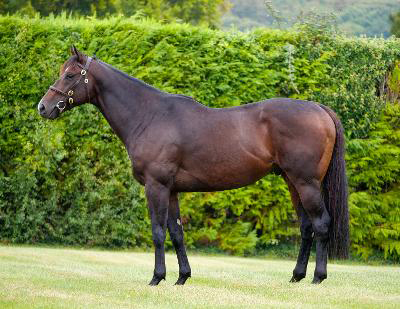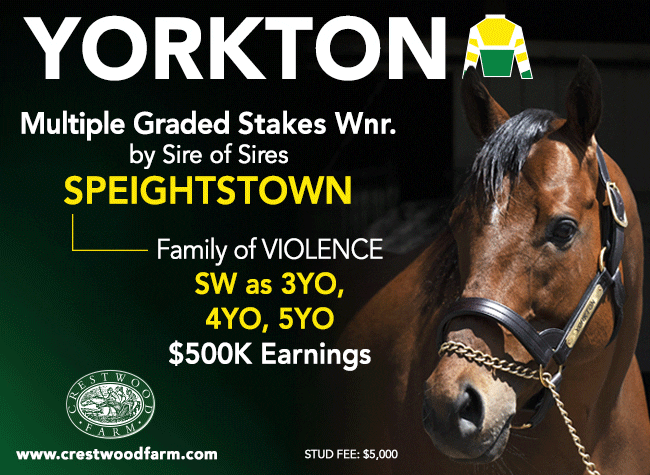By Chris McGrath
Ed Harper will never forget the time he first encountered Sergei Prokofiev in the flesh. The Whitsbury Manor Stud director was at the Rowley Mile for the G3 Cornwallis S., anticipating a big run from Heartwarming (GB) (Showcasing {GB}), a farm-bred filly leased to the Hot To Trot syndicate with Clive Cox.
“We fancied her heavily,” Harper recalls. “She'd been doing some very smart work, we knew we hadn't quite seen the best of her, today was the day. But then I saw Sergei Prokofiev in the pre-parade ring and thought, 'Crumbs, we could be in a bit of trouble here.'”
After all, the son of Scat Daddy had cost the Coolmore partners $1.1 million at the Keeneland September Sale the previous year, a graduate of David Anderson's exemplary nursery in Ontario. Though out of a Tapit half-sister to a graded stakes-winning juvenile, his overall pedigree was solid rather than sensational–an adjective that instead applied, unequivocally, to his physique.
In the event, Heartwarming found herself hopelessly stuck in traffic. But while Harper was vexed at the time, four years on he can look back at the winner's flamboyant performance as a platform for what has proved the most successful stallion launch in Whitsbury's history.
“Heartwarming got absolutely locked up,” Harper recalls. “I don't think Frankie [Dettori] even raised his whip, he was in a pocket the whole way. But meanwhile Sergei Prokofiev was just sidling out the back as if it were a half-pace spin, took a right-hand turn and overtook them all in three strides. It wasn't just the way he quickened up. He'd almost been tripping over heels, in fact I think he did at one point. It was just flabbergasting. If any of our clients ever asks me, 'Why this horse?' I just say go and watch the Cornwallis, and it answers the question.”
Enough of them did so for Sergei Prokofiev to cover 154 mares in 2021, making him not only the most popular new stallion ever launched by Whitsbury but also the busiest rookie of the intake. Partly that reflected a competitive opening fee of £6,500 (meanwhile trimmed to £6,000), but breeders obviously liked what they saw this spring with as many as 150 mares also crowding into the horse's second book.
As a result, the Foal Sale at Tattersalls this week is a pivotal moment in Sergei Prokofiev's new career. His footprint in the auction is quite staggering, with no fewer than 67 of his debut crop (before withdrawals) equating to nearly 6% of the catalogue.
The horse made a positive sales debut at Goffs last week, six foals all finding a new home at an average €34,167. But Tattersalls obviously promises to be a much headier experience for Harper and his team, not least with six Sergei Prokofiev colts and a filly among their own draft (two others scratched).
“I've been counting down the days, really,” Harper admits. “We know we've some lovely Sergei Prokofievs to sell, and our clients have been telling me likewise. Obviously the odd person has been slightly surprised to see how many he has in there. While he covered a good book in his first season, it was still less than a lot of other stallions cover, and it's really just a symptom of the way our good, regular clients include a very high proportion who sell as foals. Your typical small British breeder, for lots of different reasons, is probably leaning more towards being a foal vendor. And, at that level of nomination, a lot of our clients are among them.”
In fairness, his fee takes a lot of the pressure off those commercial breeders who appreciate the farm's candid orientation towards speed–with stellar results, once again, in the case of leading freshman Havana Grey (GB).
“Goffs went very well for Sergei,” Harper says. “They all sold, which is great, and at a very good average. The thing about his kind of fee is that you're not sweating over it for two years. I always feel that customers who make 30 or 40 grand off a six grand cover are a lot more relaxed than those that have to get massive numbers back.”
Next week is actually the consummation of something close to an obsession for Harper, tracing to long before that memorable exhibition in the Cornwallis. And, for that, he feels indebted to staff he can trust to maintain the smooth functioning of the farm.
“I think a big part of why we've been able to grow is that we have such a fantastic team here, who allow me to watch an awful lot of racing,” he explains. “It almost sounds like I'm shirking my duties, but I've learnt that it's actually the other way round. My job is to know what's happening on the racecourse. A lot of people in our industry only tend to watch races in which they have an interest. But while we're lucky enough to have four stallions with a lot of runners, I do try to watch every single 2-year-old race right through to October, November. That makes me sound like the saddest person on the planet, which I might well be. But it does mean I'm watching every race live, getting information real time, and that way I think it sinks in much deeper. And Sergei Prokofiev was one that hit me between the eyes with his first couple of runs.”
Ballydoyle gave him his debut in early April, when odds-on for a maiden at Dundalk only to be shaded in a photo by Skitter Scatter, likewise by Scat Daddy but with a run under her belt.
“I bet they were very disappointed he got beaten but he wasn't given a hard time and that filly went on to win the [G1] Moyglare Stud S.,” Harper notes. “She was a precocious little rocket, absolutely pin-ready that day. Sergei's a big strapping horse so, with what I know about him now, it's amazing to think that he was debuting as early as that. He went on to win his next race by eight lengths and never looked back. To get that size and stature and pedigree, combined with the fact that he was putting in those serious performances in April, you really don't see that too often. That's why he hit my radar so early.”
With hindsight, Harper is relieved that Sergei Prokofiev couldn't follow up his first stakes win in a strong edition of the G2 Coventry S., settling for third behind Calyx (GB) (Kingman {GB}) and Advertise (GB) (Showcasing {GB}): it would have been hard to land the horse, had he won that day. As it was, Sergei Prokofiev only cemented his talent by almost overcoming an awkward draw and a tricky passage from the rear. Similarly, even the rather fitful glimpses of his peak capacity, either side of the Cornwallis, only heightened Harper's interest.
“Because he's all speed, he needed races to fall his way,” he reasons of the 'TDN Rising Star'. “If they went off like scalded cats, he could just trot out the back. If they didn't, he'd pull hard because he wanted to go faster. But all his foals are going to know is that daddy liked to go fast. They're not going to read the form and see that they didn't go quick or whatever. In a perverse sort of way, that only underlined what I wanted to see, which is all speed.”
But there's another important dimension to this horse that needs highlighting. A personal conviction is that an ongoing schism between the American and European gene pools is preventing the kind of cyclical, mutual regeneration historically so critical to the breed's modern development. While Harper would not deny that it is dirt speed–rather than the associated ability to carry it–that primarily interests his farm, he does value the genetic variegation offered to British breeders by a son of Scat Daddy out of a Tapit mare.
“We're going down a black hole, genetically, with the stallion lines,” he says. “Everybody knows that. But it is so difficult to get out of that, when you're trying to buy a commercial stallion prospect. And that's why he was such a good opportunity.”
In those terms, it's a win-win situation. Quite apart from the different brand of speed embodied by Sergei Prokofiev, he's eligible to tap into growing American investment at the European yearling sales while providing a virtually guaranteed outcross for domestic breeders.
“Any time anybody likes the idea of using him, they can,” Harper says. “But the other thing is that very often, when you're putting size and stature into a mare, in Europe you're actually slowing that horse down, pedigree-wise. Whereas this sire-line is working so well, I think, partly because it can put size into that Danzig/Northern Dancer, little, European speed horse, but also maintain the speed. That's particularly useful for our broodmare band, which is full of Green Desert. So we can keep breeding the speed but also put back a bit of size.
“Even two-turn horses in America need speed, they have to get out on the front. And, at the end of the day, gate speed is about fast-twitch muscles. What's amazing with Scat Daddy is that he seems to gel with so many different types of pedigree. When bred to fast mares, Scat Daddy stallions get fast horses; with medium-distance mares, they still get fast horses; but longer-distance mares tend to work just as well. I've been really impressed that Scat Daddy horses get lots of different distances, and also go on lots of different ground.”
While Scat Daddy managed to overcome that transatlantic barrier, achieving widespread recognition in Europe, breeders here don't really have corresponding access to his sons. Caravaggio soon emigrated; Mendelssohn stands alongside his sire's premier performer, Justify, in Kentucky; El Kabeir has departed Ireland for Italy; and No Nay Never's fee has gone way beyond the reach of most. That leaves Sioux Nation, making a promising start in Ireland, plus several young sons of No Nay Never offering a more diluted strain.
So Harper is to be congratulated for spotting a pretty unique opportunity for British breeders. In fairness, he has tried a similar exercise before–again with the son of a stallion that managed to transcend the transatlantic divide primarily through Ballydoyle's enterprising patrons.
“If there is such a thing as a cheap proven horse, Due Diligence is it,” Harper remarks of War Front's son. “His price (£5,000) is governed by the fact that he's had very few runners the last couple of years, simply because he covered very few mares in years two, three and four. But he was champion first first-season sire in Britain by stakes winners–he had three in that first crop, two of them group winners–plus 25 individual winners. Well, if there'd been a first-season sire with those numbers this year, he wouldn't be that far behind Havana Grey and everybody would be talking about him.
“I know we have short memories in this industry, and 2019 seems a long time ago. But if we didn't think he had the right stuff, he wouldn't still be with us. The foals he bred after that first crop are 2-year-olds next year, and they sold very well as yearlings. He actually had his highest average yet. We have a lot of faith in him, we're sending him plenty of mares and I'm really looking forward to next year on the track with him.”
So perhaps Due Diligence could yet slipstream the terrific momentum uniting his studmates: the farm flagship Showcasing (GB) is an established phenomenon, while now there is a real buzz about the two younger guns.
Commercial breeders know how the system works. Fast new stallions will always corral big books, and anyone seeking a Sergei Prokofiev next week will plainly not be short of choice. (His remarkable fertility has contributed: Harper reckons that the farm's busiest ever rookie also had the quietest May of any new stallion, having got most of his mares in foal first time.) The bottom line is that he was priced to give the horse every chance–and he's entitled to capitalise, when you consider the flair of his best performances, his refreshing genes and that knockout physique.
“He's 16.1 and has bone you couldn't ask for,” Harper enthuses. “When he stepped off the lorry and first went into the stable, our stallion manager picked up his leg, just to pick his feet out and have a look at him. And he turned to me with a big smile and said, 'Holy crap, that takes some picking up!' Just the weight of his leg was different gear to the other stallions we have.
“But that just means he offers a different type of physique. I don't want to stand four stallions all offering exactly the same make and shape. At the end of the day, we're a shopkeeper of speed. As long as we're providing that, we want it to come in different shapes and sizes to give people options. He'd be a good 75 kilos heavier than our other stallions. But when you see him on the move, he has a massive, relaxed stride, so he has the athleticism with it–and very soon people are going to see his foals walk as well.
“Watching him in the Cornwallis, I did think that if ever there were a chance to do so, I just had to get involved with this horse–without ever thinking it could actually come off. To cover 150 mares in his second season, we've never been able to touch that. The sky's the limit with this guy.”
Not a subscriber? Click here to sign up for the daily PDF or alerts.






